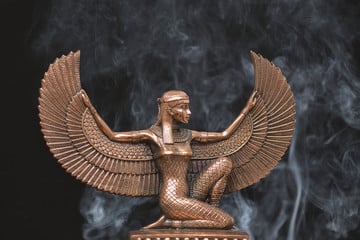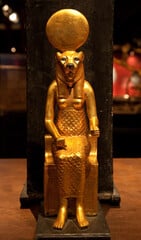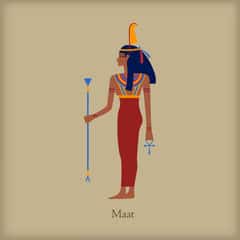4 Goddesses of Ancient Egyptian Mythology

Ancient Egypt, renowned for its rich mythology, boasted a pantheon filled with deities embodying various facets of life. Among these divine figures, the goddesses stand out as formidable forces, each with her own unique domain, symbolism and lore. Delving into the captivating realm of ancient Egyptian mythology unveils a tapestry woven with intriguing facts about these powerful goddesses, one that will help provide context for your travels to Egypt with ACIS.
1. Isis

Isis is a central figure in ancient Egyptian mythology, who symbolized maternal love, fertility, and wisdom. She was revered as a powerful magician and source of enlightenment, embodying both nurturing care and divine insight.
Protector of the Dead and Fertility Goddess
Isis watched over the deceased, guiding them to the afterlife, and blessed worshippers with fertility and abundance.
Feminine Power and Cultural Influence
Isis represented feminine strength and resilience, influencing cultures beyond Egypt. Her worship spread widely, blending with other traditions to leave a lasting legacy on religious practices throughout history.
2. Hathor

Hathor is the Mistress of Music and Joy. As the embodiment of joy, love, music, and dance, Hathor plays a pivotal role in Egyptian religious and cultural life. She is revered for bringing happiness to both gods and mortals alike, inspiring festivities and celebrations throughout the land.
Hathor is often depicted with the head of a cow or as a woman adorned with cow horns, symbolizing her association with fertility, nourishment, and maternal care.
Hathor is also known to be a compassionate guide to the afterlife, welcoming departed souls into the next realm. Her nurturing and maternal qualities extend to the pharaohs, whom she protects as a loving mother figure, ensuring their well-being and prosperity.
Associated with fertility, Hathor is invoked for blessings of abundance and prosperity. She oversees the fertility of both humans and livestock, ensuring bountiful harvests and healthy offspring. Temples dedicated to Hathor often feature musicians and dancers who perform in her honor, invoking her presence through their art.
Explore the ACIS Ancient Egypt Itinerary
3. Sekhmet

Sekhmet, a powerful goddess in ancient Egyptian myth, is often depicted with the head of a lioness, symbolizing her ferocity, strength, and prowess in battle. She embodied the destructive aspects of the sun. Sekhmet was believed to unleash her wrath upon enemies with fury. She represented the scorching heat and merciless power of the sun at its most intense, capable of bringing both life and death.
Despite her fearsome reputation, Sekhmet was also revered as a goddess of healing and protection. Egyptians believed that her fierce nature could be harnessed to combat illness and disease, making her a guardian against evil spirits and maladies.
The duality of Sekhmet’s nature, her capacity for both destruction and healing, highlights the complex and multifaceted roles of Egyptian goddesses. She embodies the paradoxical nature of life and death, embodying both chaos and order, creation and destruction.
4. Ma’at

Last but not least, there is Ma’at, the Goddess of Balance and Justice. She was often depicted with an ostrich feather on her head, symbolizing balance, harmony and righteousness.
Ma’at was a central figure in ancient Egyptian mythology, embodying the principles of cosmic order, truth, and justice. Her concept deeply influenced every aspect of Egyptian society, serving as the foundation for law, governance, religious beliefs, and moral conduct. This ensured the smooth functioning of the universe, maintaining the balance between order and chaos and right and wrong.
In the afterlife, the heart of the deceased was weighed against her feather of truth in the judgment scene, determining their fate in the afterlife. Her teachings emphasized the importance of honesty, integrity, and ethical behavior in daily life, guiding individuals towards social harmony.











Thank you for sharing this insightful information about Egyptian deities like Isis, Sekhmet, Ma’at, and Hathor! I’d just like to add that we shouldn’t forget Amun Ra: the Creator and Sun God in Ancient Egypt, whose role was pivotal in Egyptian mythology.
Todo bien aquí estudiando Egipto gracias a dios